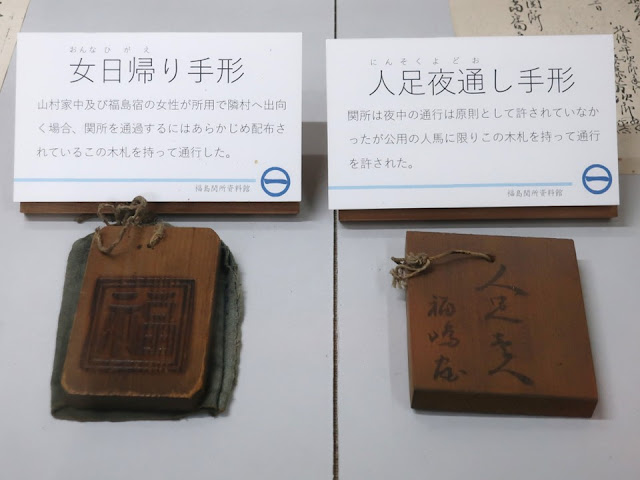There were checkpoints at major highways until the Edoperiod (1603~1868). Kiso-Fukushima checkpoint was one of the four major ones along with Hakone, Arai and Usui back then.
The checkpoint museum was rebuilt after the
checkpoint was abolished; the building is smaller than it was, however, we can
imagine the checkpoint. The exhibited documents (most of them are copies), especially
passports, tells us how people traveled and enjoyed their trip.
Yamamura’s crests are on the curtain. Yamamura clan was the head of the checkpoint.
丸に一は、関守を務めた山村家の紋です。
There are many exhibits such as weapons and documents in a lower officials’ office.
下番所の部屋は資料や関所で使った道具などの展示室になっています。
The large fans on the left were used to change a wind direction during fire in order to prevent fire spreading. Were they useful?
左の大うちわは火消し道具で、火が他所へ移らないように風の方向を変えたといいますが、凄い発想ですね。
An office which issued a passport sent an imprint of a seal (exhibits) to the checkpoint officer. The checkpoint official verified the seal against the traveler’s one on their passport.
関所手形の発行部署から関所へ送られてきた印鑑です。関所では、通行人の印鑑と合致しているかを確認しました。
We needed a passport even to visit another village back then. The wooden tags above were multiple-journey passports. A maid who worked at inn in Kiso-Fukushima had the tag on the left. An official courier had the tag on the right; he brought luggage and passed the checkpoint even at night. Those were similar to commuter passes.
仕事などで隣村へ出向く人や、公用の人足は木札で通行しました。定期券のようなものですね。
The paper below was a passport of a woman from the southern village. The table upper left shows 17 women or female groups of the village passed the check point from 1855 to 1867. Interestingly, 11 groups traveled to have their eyes treated and 3 groups did for hot-spring cure. A group of five women made a pilgrimage to Zenkouji (temple). Even officials could not prohibit the trips for treatment and worship.
On the other hand, women from the northern village passed to work at Kiso-Fukushima, to get married, or to made pilgrimage to Ise Shrine.
The passports tell us the trips of the ordinary people back then. Only women were required to renew their passport to go to the next checkpoint; it took around two hours for the paperwork. Some female travelers avoided to pass Fukushima, and walked in mountains to proceed.
下は、南側にある木曽・黒沢村(現木曽町三岳地区)の女手形です。左上の表は1855年から1867年に通過した17件のリストですが、なんと11件が眼病治療などの治療目的、3件は湯治でした。湯治の行き先は、松本市山辺が2件、大野川(白骨温泉?)が1件です。善光寺参詣は1件で、女性5人の名がありました。治療と信仰が旅行の理由になっていました。
一方、北側にある宮ノ越村からは、福島宿での年季奉公、嫁入り、里帰り、伊勢参詣や西国巡礼などが目的で関を通りました。
手形は人びとの旅を語ってくれますね。江戸へいく女性の手形は、福島関所へ提出し、碓井関所への書き替え手形を発行してもらいました。約2時間かかったそうですが、関所には手形が残りました。女性の調べが厳しい福島関所を避けて、伊那路を通った人たちもいます。
The exhibit above is the book of red seals of temples. After visiting a temple, a red stamp was given to her (Mrs. Kiyo) who was the owner of the book. She made Shikoku 88 temples pilgrimage in 1829. I’m sure the book was her treasure: the distance from her village (Kiso-Fukushima) to Shikoku is around 500km. Collecting red seals of temples and shrines is very popular among Japanese even until now.
1829年、四国八十八カ所の集印帖です。持ち主は福島宿のさよさん。遠方への旅ですね。
The religious groups (kou) to Mt. Ontake increased rapidly in the late 18th century. They had the passport above. They had a banner on which the crest (upper right) was dyed, marched toward the sacred mountain and passed the checkpoint. It’s a cheerful tour. The banner to visit Ise Shrine is exhibited in Arai checkpoint museum.
御嶽講社の手形です。寛政年間(1789-1801)以降急増し、印が入った紙の幟を立てて通行しました。楽しい旅ですね。赤地に黒で「お可げ(おかげ)」と書いた幟旗(幅60cm、長さ185cm)を立てて伊勢参りをした人たちもいるのですよ。新居関所史料館に展示されていました。
I proceeded to the next room.
次の部屋、上番所へと進みます。
An official permitted a traveler to pass there. You can wear the outfit and the chonmage wig above, and take photos.
関所通過の裁可を出す上番所には、身につけて撮影できるかつらや裃があります。
Fire-proof storage、土蔵
The small temporary exhibition “Kiso old highway map for walker” was held when I visited.
「ウォークマップでみる木曽路」というミニ企画展が開かれていました。
Guidebooks in the Edo period (1603~1868) were displayed. Edo people boosted their image of traveling like us.
江戸時代のガイドブック(東海道名所図会)。今と同じく、この本を見て、旅へのイメージを膨らませていたのでしょうねえ。
Drafts of the walker’s guidebook were displayed. I also use the detail map of Kiso old highway. It is You can see it on the website (http://cat.kisoji.com/nakasendo_walking_map_en/).
今のガイドブックを作った方のスケッチが展示されていました。詳細な地図があると、楽しく中山道をたどれます。私も使っています。ウエブで公開されています(http://cat.kisoji.com/nakasendo_walking_map_jp/)。
The gate and the fence of the checkpoint are on the cliff of Kiso River.
木曽川の崖の上に、関所跡の門や柵が見えます。
The checkpoint site is at the north end of Kiso-Fukushima town.
関所跡は木曽福島の町の北端です。
The mansion above was owned by Yamamura clan. They took the role of the checkpoint head and ruled Kiso region under the lord of Owari in Aichi prefecture at present. Some buildings and the garden remain and are opened to the public.
町には、関守と木曽代官を兼ねた尾張藩山村氏(5700石)の屋敷があり、一部の建物と庭園が現存、「山村代官屋敷」として公開されています。木材を背景にした財力をうかがえます。
Official website: https://www.town-kiso.com/facility/100024/
(in Japanese)
Visited in August, 2023
Previous post (museum in the same town): Kiso-Fukushima
and Festival Museum、木曽福島とまつり会館
Next post (museum in the same town): Kiso-Fukushima local museum、木曽福島郷土館


















Comments
Post a Comment